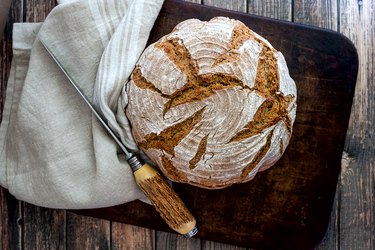
You need some type of leavening agent when you're baking bread — unless you're baking flatbread, of course. Self-rising flour and yeast are both candidates, but they shouldn't be used together. The type of bread you are baking will determine which type of leavener you should use.
Tip
Self-rising flour and yeast both make bread rise. Using both at the same time will have undesirable effects.
Video of the Day
Self-Rising Flour and Yeast
Self-rising flour is regular flour that is pre-mixed with baking soda and salt. Baking soda catalyzes a chemical reaction when it is combined with an acidic ingredient in the batter, such as buttermilk, yogurt or vinegar. This reaction produces carbon dioxide, which forms air bubbles that cause the batter to expand and rise.
Video of the Day
Yeast works in a similar way, but it's not a chemical leavener like baking soda. Yeast is a microscopic fungus that's activated when it comes in contact with moisture. The organisms feed on the sugars in flour and produce carbon dioxide as a byproduct.
The main differences between baking soda and yeast are time and flavor. Baking soda is fast-acting; when your batter is mixed, you can pop it right in the oven. With yeast, you have to wait for the microbes to do their work, which can take hours. Yeast also contributes a distinctive flavor that is desirable in many breads that baking soda does not.
Read more: 10 Ingredients to Always Avoid in Bread (Plus, 7 Bread Brands That Are Your Best Bets!)
Too Much of a Good Thing
If you were to use both self-rising flour and yeast, your bread would likely rise too much, which can cause the top to crack and even cave in. It will also affect the flavor. Since self-rising flour already contains salt, using it in a recipe that calls for additional salt, such as one written for yeast bread, will make your bread too salty.
Having too much salt can also affect the structure of your bread, as salt firms the gluten. Gluten is the substance responsible for providing the elastic texture of dough and a chewy baked bread. Excess salt could make the structure too tight and tough.
Additionally, salt retards the action of yeast. If there is too much salt in your bread dough, the yeast will ferment very slowly. This may, in fact, help to counteract the rise created by the baking soda, but it simply depends on the different rations in the batter. According to King Arthur Flour, the suggested maximum concentration of salt in bread is 2 percent.
Read more: Whole-Grain Bread Vs. White Bread
Which Flour Should You Use?
When your recipe calls for yeast, don't use self-rising flour. But which flour should you use then? You've got a few choices:
Bread flour is specifically designed for many types of bread. Bread flour contains more protein than other flours. A higher protein content produces more gluten, which is desirable when you want to create a chewier texture in rustic breads and hearth loaves. Some people also use bread flour to make pizza dough.
All-purpose flour is your standard white flour. It's made from whole-grain wheat but is milled to give it a finer texture and longer shelf-life. As its name implies, it can be used in almost anything — except those breads that benefit from a chewier texture. But it works just fine for softer breads such as dinner rolls and sandwich loaves.
Whole wheat flour is unrefined. It retains the bran and germ that have been removed from refined, white all-purpose flour. Therefore, its texture isn't as fine, and it has a slightly nutty flavor. Most breads can easily be made with whole wheat.
Choosing whole-wheat flour is a great choice for your health. Refined white flour lacks the fiber, vitamins and minerals of whole-grain flour. According to Mayo Clinic, eating more whole grains may help you manage your weight and reduce your risk of heart disease, diabetes, certain cancers and other chronic diseases.
Correction: An earlier version of this story incorrectly described yeast as bacteria. We appreciate readers who bring errors like these to our attention! If you spot something in one of our articles, please reach out: [email protected].
- NC State University: "The Difference Between Baking Soda and Baking Powder"
- Science of Cooking: "Bread Science 101"
- Kitchen Savvy: "Oops! Self-rising Flour in Yeast Rolls"
- King Arthur Flour: "Salt"
- Basically: "What's the Difference Between Bread Flour, All-Purpose Flour, Cake Flour, and Pastry Flour? (Phew!)"
- Harvard T.H. Chan: "Whole Grains"
- Mayo Clinic: "Whole Grains: Hearty Options for a Healthy Diet"